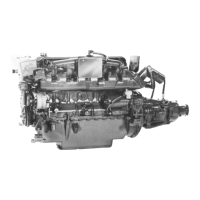A2 1
FIG.
9.
-
RAW WATER CIRCULATION SYSTEM
-+*-
*
‘
-
ENGINE
--c
J
-
Exhaust manifold
A
-
B-
-
c-
D-
Intake scoop of standard marine design, minimum 1” NPT should be used for raw water inlet. Reduce to
V4”
NPT at pump. Recommended scoop has bars across opening to prevent entry of large pieces of foreign
matter
-
Lehman part NO. EW
-
3 is perferred.
Sea
-
cock should be
1”
NPT minimum size, “gate” type opens fully to allow full, unrestricted flow of water
-
Lehman part NO. EW
-
22 preferred.
The use of an efficient, full
-
flow raw water strainer is strongly recommended to prevent clogging of pump
and exchangers by weeds, etc. Lehman part NO. EW
-
102 preferred.
If hose is employed for intake, same should be reinforced type of extra heavy construction to prevent collapse
under powerful suction of raw water pump
-
Lehman can provide such hose if required.
Winterization
of
Cooling System
Inboard type heat exchangers must be drained of raw water when exposed to freezing temperatures. Raw water,
pump, water inlet piping and intake strainer should likewise be drained when subjected to extreme cold.
If
however, the vessel is being permanently laid up for the duration of the cold weather, we recommend mixing an
anti
-
freeze solution and running this solution through the sea water system with the engine idling until discharged
from the exhaust. This insures the sea strainer, coolers, heat exchanger, even the muffler and exhaust system will
be protected.
Drain points for the fresh water system will be found on the port side of each engine block, on the aft end of the
exhaust manifolds and on the heat exchanger.
Raw water drains are found on both engine and transmission coolers,
as
well as, the heat exchanger. To drain raw
water pump, loosen rear cover.
“Keel
Cooling
yy
Systems
In some cases the installation of a “keel cooling” system may be preferred to the standard “heat exchanger”
previously discussed. This system employs a series of tubes mounted on the underside of the hull through which
the engine cooling water is circulated. Such a system is beneficial when the boat is to operate in muddy or silt
-
laden
areas, however, the cooling element does produce additional hull “drag” which could affect performance in faster
boats and creates a potential hazard
if
tubes fracture or are struck by driftwood, etc.
Piping engine
to
keel cooler is quite simple. As shown in Fig. 10. the connection on underside (starboard) of
expansion tank deliver hot water from engine to keel cooler. Cooled water from keel cooler returns to engine via
connection on aft end
of
exhaust manifold. The use of 13h” I.D. hose will simplify connections, however hose must
be reinforced type
to
prevent collapsing under suction and care must be exercised when installing
to
avoid “kinks”
or the possibility of chafing.
Installations using
a“wet” exhaust will required raw water systems as shown in Fig.
9.,
but omitting heat exchanger.
When dry exhaust is employed, it is possible to eliminate use of raw water pump. Upon special order, lube and
transmission oil coolers of large size may be incorporated in the engine fresh water system. The addition of such
coolers is shown in Fig. 11.
FIG. 10. FRESH WATER CIRCULATION SYSTEM
(Keel Cooler Type)
From
keel cooler
Lube
oil
cooler
To
keel cooler
To
keel cooler
FIG.
11.
WATER CIRCULATION SYSTEM (Keel Cooler Type)
WITH LUBE AND TRANSMISSION OIL COOLERS IN
FRESH WATER FLOW.

